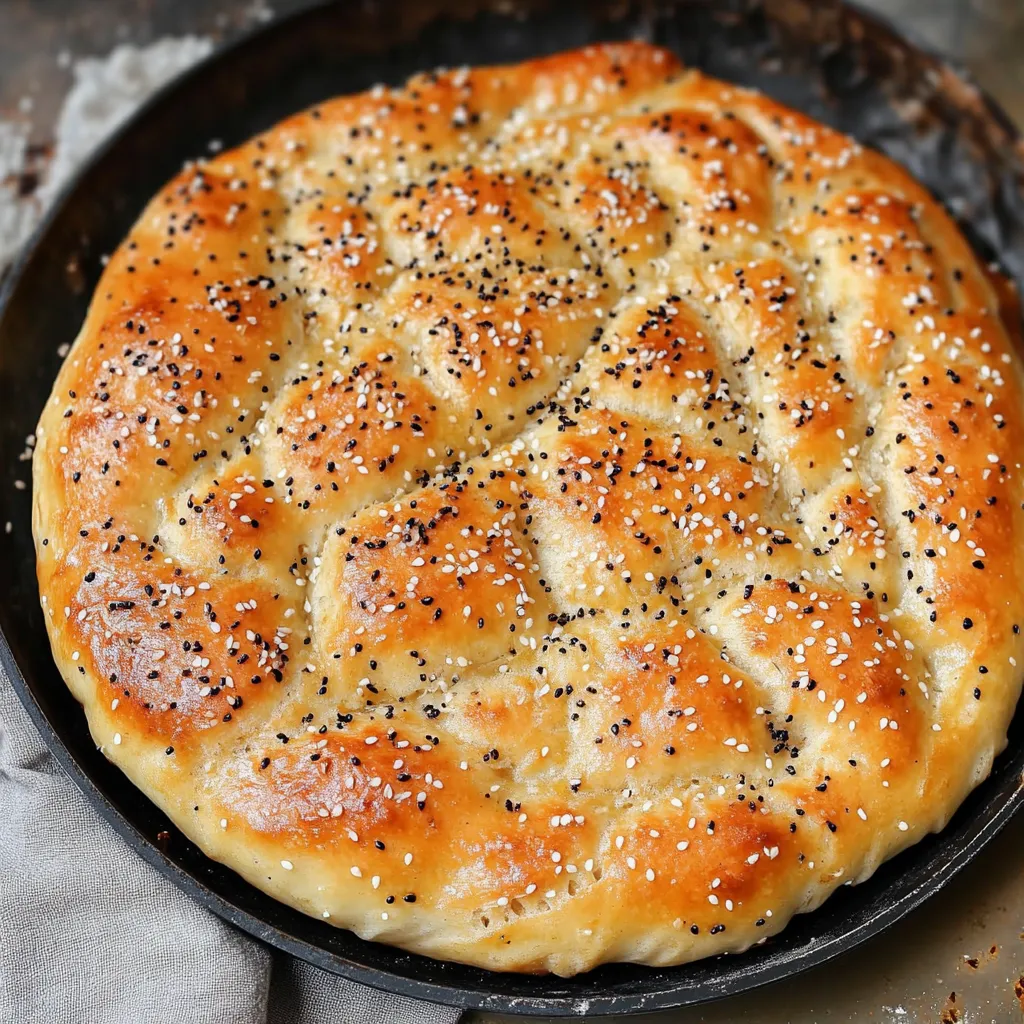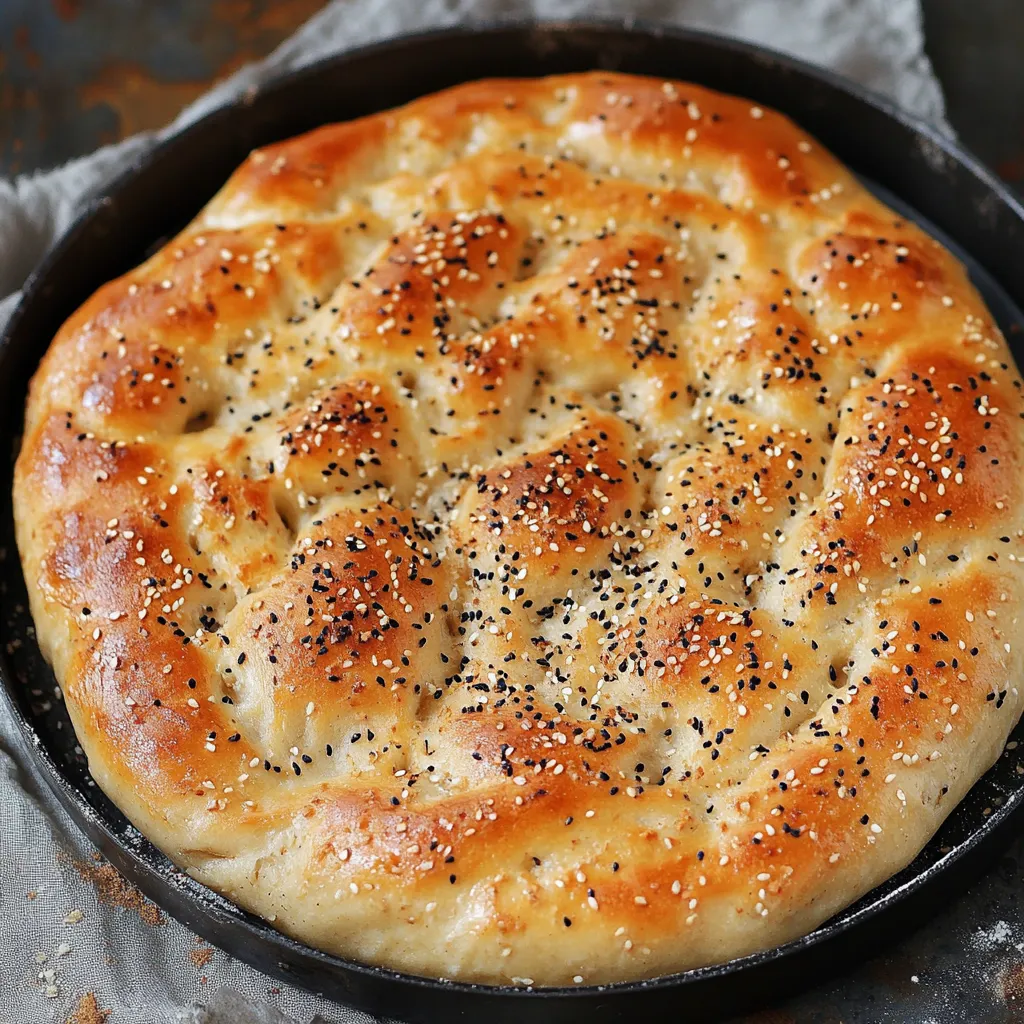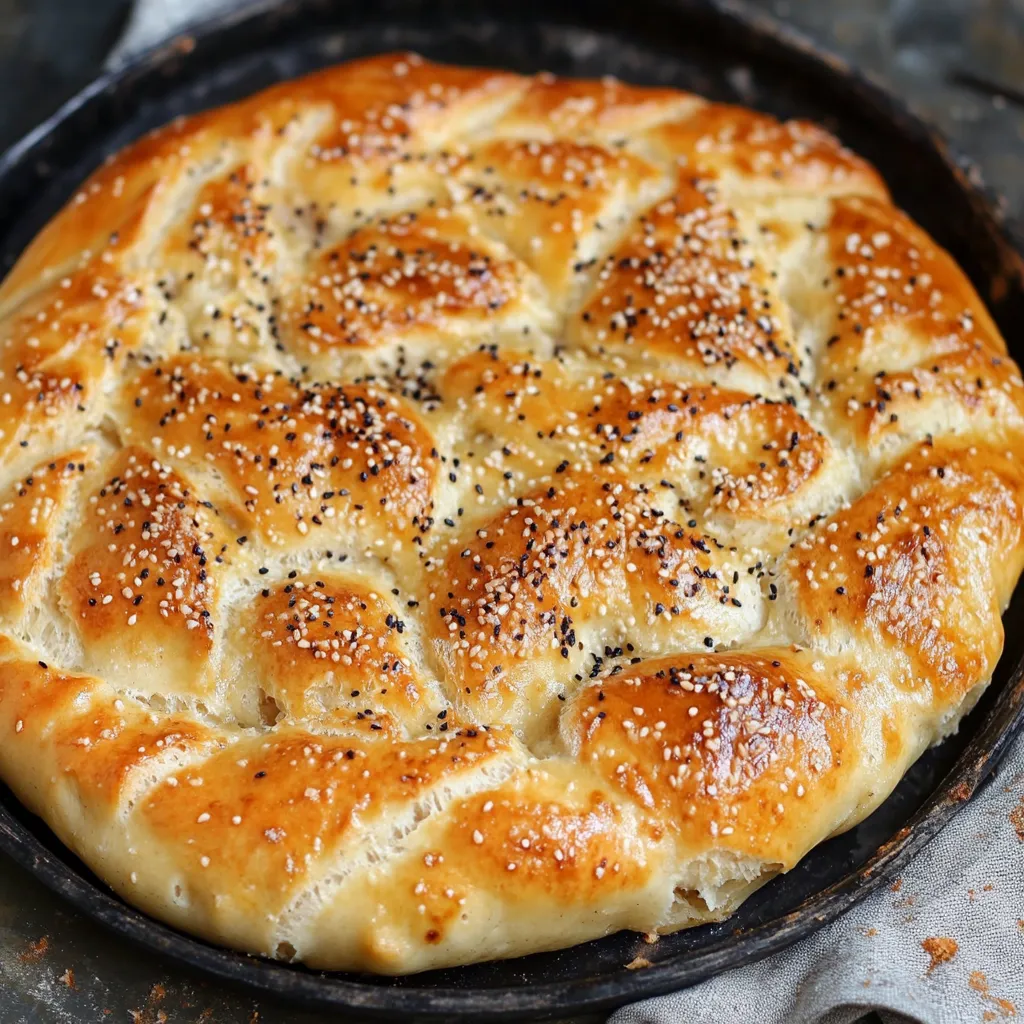 Pin it
Pin it
This hearty Turkish Pide Bread recipe brings the magic of Ramadan celebrations to your kitchen with minimal effort. The no-knead technique makes this pillowy, flavorful bread accessible even to beginner bakers, while the distinctive pattern and seed topping create a bread that's as beautiful as it is delicious.
I first made this bread during Ramadan celebrations with Turkish friends, and it's become my go-to recipe when I want to elevate a simple meal into something special. The look on guests' faces when they see the beautiful pattern is priceless every time.
Ingredients
- All purpose white flour: Forms the backbone of this bread giving it structure while remaining tender
- Salt: Enhances all the flavors and strengthens the gluten network
- Egg: Separated into white and yolk the white goes into the dough for structure while the yolk creates that gorgeous golden crust
- Olive oil: Adds richness and helps create that signature tender crumb
- Water and milk: The combination provides perfect hydration and enriches the dough
- Sugar: Feeds the yeast and adds subtle sweetness
- Active dry yeast: Provides the perfect rise look for fresh yeast that hasn't expired
- Plain yogurt: Adds tanginess and helps create that beautiful golden crust when mixed with egg yolk
- Nigella seeds: Sometimes called black cumin these add a distinctive slightly bitter oniony flavor traditional to Turkish breads
- White sesame seeds: Toast beautifully during baking adding nutty flavor and visual appeal
Step-by-Step Instructions
- Activate the yeast:
- Combine warm water and milk at around 100°F not too hot or you'll kill the yeast with the sugar and dry yeast in a bowl. Stir gently and let it sit undisturbed for 5-10 minutes until it becomes foamy and fragrant. This step ensures your yeast is alive and will give your bread a proper rise.
- Prepare the wet sticky dough:
- In a large bowl sift the flour together with salt to distribute evenly. Make a well in the center and pour in your activated yeast mixture along with olive oil and egg white. Mix with a wooden spoon until completely incorporated. The dough will be sticky and wetter than traditional bread dough this is exactly what you want. The high hydration creates those beautiful air pockets.
- First rise:
- Cover your bowl with a clean kitchen towel and place in a warm draft-free area ideally around 75-80°F. Allow the dough to rise for 30-40 minutes until it has doubled in size. In colder environments this might take up to an hour. The dough should look puffy and have visible air bubbles.
- Shape without deflating:
- Line a baking sheet with parchment paper and dust lightly with flour. Gently turn your dough out onto the prepared surface. Using floured fingertips very gently shape into a circular disc about 9-10 inches in diameter. Work carefully to preserve as many air bubbles as possible they create the light texture Turkish pide is known for.
- Second rise:
- Cover the shaped dough with the kitchen towel again and allow to rest for another 20 minutes. During this time the dough will relax and puff up slightly while your oven preheats to 400°F.
- Create the distinctive pattern:
- Mix the reserved egg yolk with yogurt and a teaspoon of water to create a smooth egg wash. Brush this mixture generously over the entire surface of the dough. Using your finger gently press a circular indentation about an inch from the edge all around the bread. Then create a grid pattern inside this circle by pressing lines vertically and horizontally across the surface creating distinctive squares.
 Pin it
Pin it
The nigella seeds are what truly make this bread special for me. Their slightly peppery flavor brings me right back to the streets of Istanbul where vendors sell fresh pide fragrant with these distinctive black seeds. My Turkish friend's grandmother told me they have been used for centuries as both flavor and medicine.
Storing Your Pide
Turkish pide is best enjoyed on the day it's made when the crust is crisp and the interior soft and warm. However you can store it wrapped in a clean kitchen towel at room temperature for up to 2 days. To refresh reheat in a 350°F oven for about 5 minutes until warmed through. For longer storage freeze the cooled bread in an airtight container or freezer bag for up to 3 months. Thaw at room temperature and reheat before serving.
Perfect Pairings
This versatile bread shines when served alongside traditional Turkish dishes like kebabs or rich stews. The pillowy texture makes it perfect for sopping up flavorful sauces. During Ramadan it traditionally accompanies iftar meals when the fast is broken at sunset. I love serving it with a simple spread of mezze including hummus olive oil with za'atar and labneh. The bread can also be split and used for sandwiches or cut into wedges for dipping.
Troubleshooting Pide Problems
If your dough seems too wet add flour one tablespoon at a time until it reaches a very soft but workable consistency. If the dough is too dry add more warm water a teaspoon at a time. The ambient temperature greatly affects rising time if your kitchen is cold place the dough near a warm oven or in the oven with just the light on. For the distinctive pattern dont press too deeply just enough to create visible indentations without deflating your dough completely.
 Pin it
Pin it
With minimal effort and ingredients, this Turkish pide bread will surely become a favorite centerpiece on your dining table!
Frequently Asked Questions
- → Why don't you need to knead this Turkish bread?
The dough has higher hydration (more liquid) which allows gluten to develop naturally during the proving period without kneading. The wet, sticky consistency and longer rest time replace the mechanical gluten development that kneading would provide.
- → What creates the distinctive pattern on Turkish pide?
The pattern comes from finger indentations made after the second proving. First, create a circle about 1-inch from the edge, then make a grid of crisscrossed lines within that circle. This traditional technique gives the bread its characteristic look and helps with even baking.
- → Can I make this bread without the egg wash?
Yes, though the egg-yogurt wash contributes to the golden color and slight tanginess. For an egg-free version, you could brush with just yogurt thinned with water, or use milk or olive oil for a different but still attractive finish.
- → What are nigella seeds and can I substitute them?
Nigella seeds (also called black cumin or kalonji) have a distinctive oniony, oregano-like flavor that's traditional for Turkish pide. If unavailable, you could substitute black sesame seeds, poppy seeds, or even caraway, though the flavor profile will change.
- → How do I know when my dough has proved enough?
The dough should roughly double in size during the first proving (30-40 minutes). It should look puffy and when you gently press a finger into it, the indentation should slowly spring back but not completely disappear. Weather and temperature affect proving time.
- → Can I prepare this bread ahead of time?
You can prepare the dough and refrigerate it after the first rise for up to 24 hours, which actually enhances flavor development. Bring to room temperature before shaping, then continue with the second rise and baking steps.
